The Douglas home is the culminating work of Meier, where all the ideas developed in the experiments in single-family homes resulted in a more balanced and imaginative structure. Built in the 1970’s, it became a symbol of Rationalism.
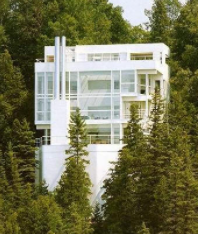
Image source: https://usmodernist.org/meier.htm
The James and Jean Douglas House (or just Douglas House) is a residence located at 3490 South Lake Shore Drive on the shore of Lake Michigan in Friendship Township near Harbor Springs, Michigan. It is located on a very steep slope overlooking the lake. It is a four story, bright white, Modern structure with a flat roof clad with redwood. The overall form of the house is a large rectangle set on end. The rear wall of the house, which faces the lake, makes extensive use of glass to provide maximum views. The house is built of redwood (vertical Tongue and Groove boards) and is almost completely white. The foundation consists of a series of pilings hammered into the earth.
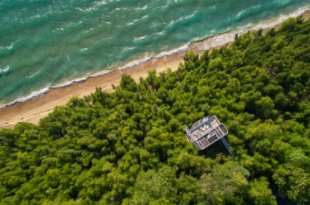
Image source:https://www.douglashouse.org/architect
Project commission
Completed in 1973, the home was commissioned by the Douglases after they contacted Meier to buy the blueprints for his earlier Smith House in Connecticut.
I replied that while I was not prepared to sell the drawings I would certainly be willing to design a new house for them along similar lines.
He first started designing for a site on a residential subdivision in northern Michigan, but the developer dismissed the proposal because it didn’t have a pitched roof.
To my delight, the Douglases responded to this impasse by promptly selling the plot and looking for another site, and that was the beginning of a very gratifying collaboration.
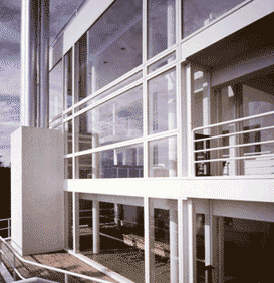
Images source: https://usmodernist.org/meier.htm
They found a remote spot close to Harbor Springs – a steep patch of forested land that slopes down to Lake Michigan. Its topography and orientation towards the water means that the 4,500-square-foot (418-square-metre) house has to be entered on the top of its five stories, accessed from the street via a bridge.
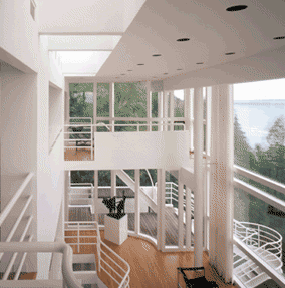
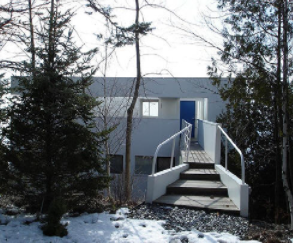
Images source: https://usmodernist.org/meier.htm
Description
The entry is on the east side of the house facing the road, which Meier considers the “private” zone and is expanded by a roof-level bridge. Once inside the entry vestibule there is a continuation to a roof-deck, and the living room and kitchen are seen two stories below with the fire place in view across from the entry, typical in homes designed by Meier.
It is truly a house of opposites: to leave the house for instance, you go up instead of down.

Image source: https://usmodernist.org/meier.htm
The “public” zone of the house, including the living room and dining room, faces Lake Michigan and gives the impression of a completely different place when compared to the deceiving one-story entry space. The living room is open to the surrounding landscape with three large floor-to-ceiling windows, which was heavily used on the western side of the house to take advantage of the view. It also receives sunlight through a skylight that further separates the public and private zones.

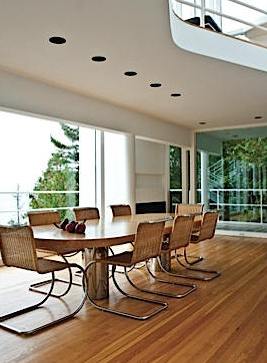
Images source: https://usmodernist.org/meier.htm
The bedrooms were designed small and cabin-like, intimate for their private function. The layers of the floors are read on the exterior through these window mullions, and the interior public and private zones can also be determined depending on the number and sizes of the windows.
Circulation through the house is primarily horizontal with the open floor plans except for two staircases, one interior and one exterior, on the corners of the house. Their placement was intended in order to not interrupt the horizontal views towards the outdoors.
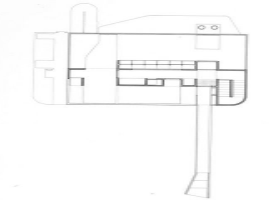
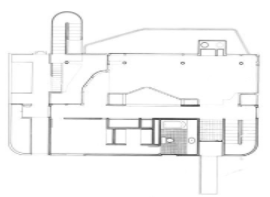
Images source: https://www.archdaily.com/61276/ad-classics-douglas-house-richard-meier
After a three year construction period, the Douglas House was completed. Meier furnished the home with furniture designed by Le Corbusier, Mies van der Rohe, and himself, and when completed it needed no ornamentation other than the nature it was designed around. Meier’s work enabled the house to extend with the natural horizontals of the shoreline, the lake’s surface, and the horizon while following the pattern of the trees with vertical mullions, creating generous spacious continuity from interior to exterior.
Concept
Douglas said,
White is the most wonderful colour […] White conventionally has always been seen as a symbol of perfection, of purity and clarity.
The intention was to create a strong visual contrast to the landscape. As is typical of Meier buildings, the house is completely white made with reinforced concrete and glass. The white of the house allows it to stick out as a man-made object on the landscape during the changing colors of the seasons, which can be experienced inside through the large glass panels.
These natural surroundings were also taken into consideration during the construction of the house where as few trees were removed as possible in order to leave the landscape in its most natural state while forcing the house to integrate with it.
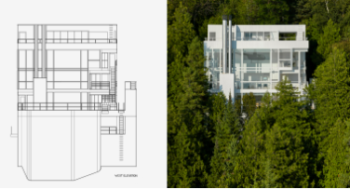
Image source:https://www.douglashouse.org/architect
In this house, Meier proposes formal, space-rich compositions. He organized the internal space such that the small, tight main entrance opens into a large space encased in glass. This style allowed him to express various themes: the contrast between light and shadow, the change in spatial scale, and access via ramps, bridges and stairs.
Awards
Richard Meier’s famous “Douglas House” has been included on the united states national register of historic places, becoming part of a select list of cultural resources deemed worthy of preservation. Recognized by the national park service US department of the interior.
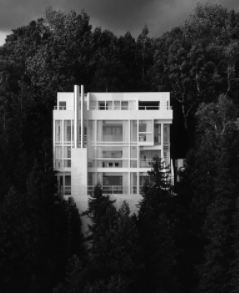
In 2007, the American Institute of Architects listed the Douglas House as one of the top 150 structures on its “America’s Favorite Architecture” list. In 2016, the Douglas House was added to the National Register of Historic Places.
The house has remained intact, with no additions or modifications to the physical structure, and no changes to room uses or layouts.
Info source:
https://en.wikipedia.org/wiki/Douglas_House_(Harbor_Springs,_Michigan)
https://www.archdaily.com/61276/ad-classics-douglas-house-richard-meier
